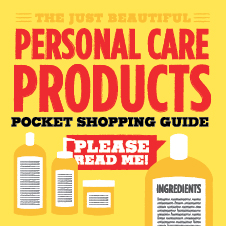Campaigning for awareness and action: Just Beautiful [Case Study]
According to Environmental Defence, before a typical Canadian makes it to the breakfast table, he or she has probably used almost 15 personal care products with over 100 toxic ingredients.
In Canada, cosmetics refer to any product used for grooming – which can include men’s, women’s and even baby care products. Unfortunately, as products are released into the marketplace, policy and regulations lag behind the latest research. The result: every day, Canadians are exposed to chemicals while using soaps, cosmetics, deodorants, perfumes, lotions and more – not all of which have been tested for safety. In fact, many cosmetic ingredients are known or suspected of causing health problems like cancer, birth defects, infertility, breathing problems, neurological problems and more.
 Environmental Defence has a proven track record of advocating for the removal of toxins from consumer products. For example, in 2008 the organization successfully led the charge to get toxic bisphenol A (BPA) out of baby bottles in Canada.
Environmental Defence has a proven track record of advocating for the removal of toxins from consumer products. For example, in 2008 the organization successfully led the charge to get toxic bisphenol A (BPA) out of baby bottles in Canada.
In 2010, Environmental Defence turned significant focus to the problem of toxins in cosmetics and personal care products through its Just Beautiful campaign.
“Under current laws, manufacturers don’t have to list all of the ingredients in cosmetics, making it difficult for consumers to make informed purchasing decisions,” explains Maggie MacDonald, Toxics Program Manager with Environmental Defence. “Often, people perceive that because a product is for sale it is safe; which is not necessarily the case. Not only are there health issues and sensitivities related to cosmetic ingredients, some of the chemicals are not understood.”
The Campaign
The Just Beautiful campaign was established to educate the Canadian public about the harmful chemicals that can be found in personal care products. Environmental Defence is working with the federal government to remove known toxins from cosmetics and to increase transparency on product labels, while working with companies on safer alternatives.
The message
To improve consumer literacy around toxins in cosmetics, Environmental Defence has identified the Toxic Ten: the top ten ingredients to avoid when shopping for personal care products – and urges companies to stop using them.
The tactics
To deliver the campaign message and advocate for change, Environmental Defence has deployed a number of powerful tactics since 2010. The tactics were selected based on Environmental Defence’s past success with campaigns against toxins, such as those used in household products.
“We tapped into our experience with what has worked, what has resonated, and what didn’t,” explains MacDonald. “The idea that cosmetics, which are applied directly on your skin, are releasing harmful chemicals such as phthalates, ignites even more curiosity. We added new tactics to the mix based on the power of visuals, such as the Art Attack and the products showcased at the Eco Beauty Market. And we leveraged the power of research by communicating findings in our special reports.”
Research Reports
Environmental Defence has conducted a number of research studies – testing both products and people – throughout the campaign, sharing the results back in the form of consumer-accessible reports. Research report topics include:
- The Manscape: The Dirt on Toxic Ingredients in Men’s Body Care Products
- The Trouble with Triclosan: How a Pervasive Antibacterial Chemical is Polluting our World and our Bodies
- Heavy Metal Hazard: The Health Risks of Hidden Heavy Metals in Face Makeup
- The Toxic Nation Guide to Cosmetics Laws: Canada vs. the European Union
- Not so Sexy: The Health Risks of Secret Chemicals in Fragrance, Canadian Edition
Pledge
Manufacturers and retailers can take the Just Beautiful Pledge, which promotes those providing full disclosure of product ingredients and making and/or selling products that are free of the Toxic Ten ingredients.

Shopping Guide
The Just Beautiful Personal Care Products Pocket Shopping Guide lists the Toxic Ten ingredients to avoid when shopping for personal care products and directs consumers online to learn more about the potential health impacts.
Petition
Throughout the campaign elements, consumers are invited to sign a petition to the Canadian Cosmetic, Toiletry and Fragrance Association pressing for the removal of the Toxic Ten substances from products and the full disclosure of all product ingredients on labels and online.
Live events
1. Eco-Beauty Markets: Environmental Defence hosted three Eco-Beauty Markets in 2012. Shoppers were invited to sample and shop for safe skincare, cosmetic and hair care products and bring in toxic products for safe disposal.
2. Art Attack: In fall of 2012, artists created 12’x15’ murals at four Ontario university campuses using toxic makeup collected from consumers. The use of visual art created interest, drawing students in to learn more and to sign the mural with toxic cosmetics to demonstrate support for a petition. Students also signed paper petitions which were sent to the four largest cosmetic companies in Canada (Estée Lauder, L’Oréal, Proctor & Gamble and Unilever) asking the cosmetics industry to remove the Toxic Ten from cosmetics, and fully disclose all ingredients, including fragrance ingredients.
Newsletter
A Toxic Nation newsletter is used to keep interested/engaged consumers updated and aware of new campaign developments.
Blog
The Environmental Defence blog provides Environmental Defence with a way to speak to a broader audience. The content published on the blog attracts those searching for information or stories on the topic.
Video
A video PSA called Try to Look Pretty without Poisoning Yourself was created to raise awareness about this issue by using humour. The video is about the dangerous “game” Canadians play every day while using cosmetics. It follows a game show contestant named Jackie, as she tries to pick safe products.
The results
Just Beautiful launched in 2010 as a three-year campaign and since that time has successfully drawn in and engaged consumers about a topic with previously low awareness. Some of the successes include:
The number of businesses signed up to the Just Beautiful pledge has grown rapidly; in January 2012, approximately 11 businesses had signed up. To date, 40 businesses have now signed the pledge, demonstrating significant shifting in industry standards.
The Eco-Beauty markets have grown more than 200% in attendance year-over-year. The most recent Eco-Beauty Market included a Twitter party with 20 well-known, active Canadian bloggers and Twitter users who were invited to an exclusive talk held by then Executive Director Rick Smith and award-winning broadcaster and bestselling author, Gill Deacon. As a result, the organization was a trending topic nationally on Twitter that evening.
The Art Attack events proved to be a hugely successful student outreach effort. The murals and materials drew students’ attention to the Toxic Ten and thousands signed a petition.
Due to Environmental Defence’s efforts to raise awareness about the harmful effects of triclosan, including a report on the topic, the anti-bacterial chemical was declared toxic to the environment by Environment Canada last year.
Since its launch in January 2012, the Try to Look Pretty Without Poisoning Yourself video has received more than 165,000 views on YouTube, making it one of the most popular YouTube videos by a Canadian environmental NGO to date.
Learn more
Environmental Defence has much more planned in the area of toxins, with specific plans this spring to tackle toxins linked to cancer and hormone disruption. To stay in the loop, check out the Environmental Defence blog and Toxic Nation E-news. And to learn how you can get involved, visit the Take Action section of the website.



 PRINT
PRINT
